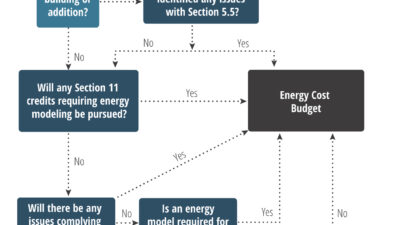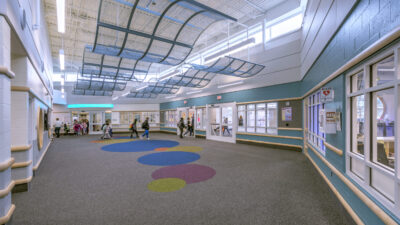It can be quite literally full of holes. The building draws unconditioned air in, then leaks conditioned air back out through holes, cracks, gaps and other leaks of varying size. It’s called “uncontrolled” air leakage, and it costs a lot of money. The U.S. Dept. of Energy estimates uncontrolled air leakage can account for 30% or more of a building’s heating and cooling costs, and contribute to problems with moisture.
Most industrial, commercial and institutional buildings in the United States leak air. The good news is it’s not the HVAC engineer’s fault. You can design the most efficient HVAC system imaginable, and the building will still draw in air. However, a simple understanding of the interaction between the HVAC and the building envelope can help you prevent future buildings from drawing air in and leaking air out with the inclusion of a continuous air barrier system. Here’s how it works:
Air leakage occurs through cracks, gaps, holes, pores in materials and other openings in the building envelope. Airflow is the result of pressure differences. When air leaks, it takes with it heat, water vapor, smoke, pollutants, dust, odors, allergens and anything else it can find and carry. Energy moves from regions of high to regions of lesser potential: hot and cold, high pressure to low, and so on.
There are three major sources of pressure that cause air to leak: wind pressure, stack pressure and HVAC fan pressure. Of the three, wind is usually the greatest. When averaged out over the course of a year, it is about 10-15 mph (0.2-0.3 psf or 10-14 Pa) in most locations in North America. If it hits the building straight on, air enters the envelope on the windward side and exits on the other three sides and at the top, through the roof. If the wind hits at an angle, air exits the building on the two leeward sides and the roof.
Stack effect, also sometimes referred to as chimney effect, is caused by buoyancy or the simple physics lesson that hot air rises. The weight of the column of conditioned air inside the building compared with that outside creates a pressure difference across the building envelope. The taller the building is, the greater the stack pressure will be. Warm, conditioned air escapes through holes at the top of the building and at the roof. The resulting lower pressure at the bottom of the building draws in air from the surrounding environment.
The third pressure comes from the mechanical system itself. Mechanical engineers and on-site managers often choose to bring in makeup air to increase pressure and overcome the infiltration at the base of the building. Unfortunately, this increases pressure at the top, causing more exfiltration problems in that area.
How does an air barrier system increase energy efficiency?
When uncontrolled air leakage occurs, the HVAC system has to work harder to maintain the indoor environment. An effective air barrier system, quite simply, controls air movement into and out of the building. This allows the HVAC system to do its job uncompromised by having to make up for a disproportionately large amount of the air it is conditioning leaving the building.
And of course, increasing the operating efficiency of the HVAC system reduces energy consumption and, therefore, operating costs. In fact, the inclusion of an effective air barrier system may allow the HVAC system to be downsized at the design stage — in some cases by a substantial amount.
According to a National Institute of Standards and Technology (NIST) report, Investigation of the Impact of Commercial Building Envelope Airtightness on HVAC Energy Use, the inclusion of an air barrier system in four sampled types and sizes of building can reduce air leakage by up to 83%. This represents a large reduction in current and future energy consumption and operating costs: potential gas savings of greater than 40%, and electrical savings of greater than 25%.
The study evaluated the energy savings of an effective air barrier requirement for non-residential buildings in five cities representing different climate zones. The methodology included blended national average heating and cooling energy prices and cost-effectiveness calculations matching the scalar ratio employed by ASHRAE 90.1. Energy simulations were performed using TRNSYS (Klein 2000). Simulations of annual energy use were run using TMY2 files (Marion and Urban 1995).
The research team selected whole building airtightness levels that were judged to be readily achievable and used these as the whole building target used in the energy modeling. The baseline buildings used in the comparison were modeled with leakage levels based on a database of commercial building leakage measurements.
Let’s look at one of the building models used in the study: the office building.
The model was a two story office building with a total floor area of 24,200 sq. ft. and a window-to-wall ratio of 0.2 with a floor-to-floor height of 12 ft., broken up between a 9-ft. occupied floor and a 3-ft. plenum per floor. The building also included a single elevator shaft.
The internal gains for the occupied spaces were divided into three parts: lighting, receptacle loads and occupants. The thermostats operated on a set point with setback/setup basis. The heating set point was 70 °F with a setback temperature of 55 °F and the cooling set point was 75 °F with a setup temperature of 90 °F.
The HVAC system included water-source heat pumps (WSHPs) with a cooling tower and a boiler serving the common loop. Each zone had its own WSHP rejecting/extracting heat from the common loop. The outdoor air for each zone was supplied to each individual heat pump, and the heat pump blower was on at all times when the zone was occupied. When the location of the building required an economizer, the outdoor air controls were applied to the individual heat pump’s airflow. With this approach, different heat pumps could have a different percentage of outdoor air at the same time depending on the loads. Three of the modeled locations included economizers and two did not. Return airflow was specified to equal 95% of supply airflow.
The results showed that reducing the air leakage rate to the target level by including a continuous air barrier system resulted in an average reduction in infiltration of 83%. The economic impact is shown in Table 1 below:
Table 1 Energy cost savings for office building
| City | Gas Savings | Electrical Savings | Total Savings |
| Bismarck | $1,854 (42%) | $1,340 (26%) | $3,195 |
| Minneapolis | $1,872 (43%) | $1,811 (33%) | $3,683 |
| St. Louis | $1,460 (57%) | $1,555 (28%) | $3,016 |
| Phoenix | $124 (77%) | $620 (9%) | $745 |
| Miami | $0 (0%) | $769 (10%) | $769 |
Note: The full report, Investigation of the Impact of Commercial Building Envelope Airtightness on HVAC Energy Use, is available for download from the NIST website at www.nist.gov
What makes an air barrier?
Air barrier systems must be constructed of materials with an air permeance rating of less than 0.004 cfm/sq. ft.when tested at their intended-use thickness in accordance with ASTM E 2178. They must be continuous throughout the building envelope with interconnected, flexible joints. The air barrier must be able to withstand positive and negative air pressures without displacement and must be durable enough to last the life of the building.
Of course, all penetrations in the air barrier must be sealed or the assembly itself becomes leaky, which defeats the purpose of installing the system in the first place.
The Air Barrier Association of America (ABAA) has published Master Specifications for several different air barrier materials and systems that meet the performance requirements of state and model Energy Codes on its website: www.airbarrier.org .
One of the most frequently specified air barrier materials is closed-cell spray-applied polyurethane foam. This is because in addition to providing an air permeance rating of less than 0.001 L/s/m2at an application thickness of 1.5 in., the material also offers an effective insulation R-value of over 6 per in. and in many states also qualifies as a vapor barrier. Spray-applied polyurethane foam is a two-component product manufactured on site but engineered in the molecular level to meet required performance criteria for every code and climate.
Spray-applied and seamless, it conforms to any shape, fully-adheres to the wall system and requires no fasteners, thereby eliminating thermal bridging, convection loss behind insulation boards, and condensing surfaces, while also increasing installation speed and reducing labor costs. It can also improve structural strength, according to testing conducted by the National Association of Home Builders (NAHB) ResearchCenter.
For the future
Although the idea of mandating air barrier systems for new commercial construction is a relatively new phenomenon in the United States, Canada has included air barriers in its National Building Code for over two decades. In recent years, Massachusetts, Wisconsin and Michigan have begun mandating air barrier systems as part of their Commercial Energy Codes. Although air barrier systems are now required by the American Society of Heating, Refrigerating and Air-Conditioning Engineers (ASHRAE’s) Advanced Energy Design Guide: Small Office Buildings, and the New Building Institute’s Benchmark for Advanced Buildings, for the first time, continuous air barrier systems may become a requirement by the ASHRAE under Addendum z to Standard 90.1-2004, Energy Standard for Buildings Except Low-Rise Residential Buildings ; at the time of writing, this Addendum was in public review .
Professional Engineers designing and specifying mechanical systems in non-residential buildings can improve performance by understanding the impact of uncontrolled air leakage and the role of the air barrier system in optimizing building energy efficiency and durability, as well as occupant comfort, health and safety. To this end, the Air Barrier Association of America provides training programs for architects, specifiers and engineers, as well as a certified installer program with third-party quality control inspections to ensure correct installation of the systems.
Additional Resources:
The National Institute of Standards and Technology (NIST) www.nist.gov
The Air Barrier Association of America www.airbarrier.org
Oak Ridge National Laboratory www.ornl.gov
The United States Department of Energy www.energy.gov
American Society of Heating, Refrigerating and Air-Conditioning Engineers (ASHRAE) www.ashrae.org
The National Institute of Building Sciences (NIBS), Whole Building Design Guide www.wbdg.org
National Association of Home Builders (NAHB) www.nahb.org
Canada Mortgage and Housing Corporation (CHMC) www.cmhc-schl.gc.ca
National Research Council of Canada www.nrc-cnrc.gc.ca



